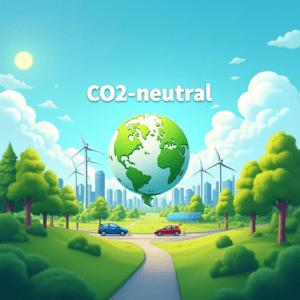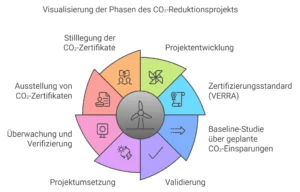CO₂ certificates, also known as emission certificates, are tradable rights that allow the holder to emit a specific amount of carbon dioxide (CO₂) or an equivalent greenhouse gas. A certificate typically represents the permission to emit one ton of CO₂. CO₂ certificates are a central tool in the fight against climate change and are used within emissions trading systems to gradually reduce greenhouse gas emissions.
Types of CO₂ Certificates
There are two main types of CO₂ certificates:
1. Regulated Emissions Trading (Cap-and-Trade): This is based on legally mandated caps for the maximum allowable emissions in specific industries or regions. A well-known example is the European Emissions Trading System (EU ETS). Companies receive a certain number of certificates or must buy them. If they reduce their emissions, they can sell surplus certificates. If they emit more than their certificates allow, they must buy additional certificates or pay penalties.
2. Voluntary CO₂ Offsetting: This form is aimed at individuals and companies who voluntarily want to offset their emissions, for example, by purchasing CO₂ certificates that finance emission reduction or sequestration projects. These certificates are often certified by standards such as the Verified Carbon Standard (VCS) or the Gold Standard, ensuring the quality and climate impact of the projects.
How the CO₂ Certificate Trading Works
CO₂ certificate trading operates on the “Cap and Trade” principle:
– Cap (Cap): An authority, such as the European Union in the case of the EU ETS, sets a cap for the total amount of emissions that can be emitted in a specific period. The number of certificates issued corresponds to this cap, and it is often gradually reduced over time to lower emissions.
– Trade (Trade): Companies that emit less than their allocated amount can sell their surplus certificates to other companies that emit more. This creates a financial incentive for emissions reduction, as companies can earn profits by selling excess certificates.
Goal and Benefits of CO₂ Certificates
CO₂ certificates aim to motivate companies to reduce their emissions over the long term. The trading system allows emissions to be reduced where it is economically most efficient. This optimizes costs and encourages innovation for emissions reduction. Through the continuous lowering of the maximum allowable emissions in the regulated trading system, the goal of climate neutrality is gradually pursued.
Criticism of CO₂ Certificates
There is also criticism of the CO₂ certificate system:
– Carbon Leakage: Companies could move their production to countries without strict emissions regulations, which would not reduce global emissions but only shift them.
– Greenwashing: In the voluntary market, CO₂ offsetting is often criticized as a “buy-out” when companies purchase CO₂ certificates without sustainably reducing their own emissions.
– Unclear Effectiveness: Some certificates, especially in the voluntary market, have questionable climate impacts, for example, due to inadequate verification of the supported projects.
Conclusion
CO₂ certificates are an important climate protection tool and contribute to reducing emissions and promoting investments in environmentally friendly technologies. Stricter regulation and transparent standards could further improve their effectiveness and make the system more efficient overall.
Further details can be found in the Wikipedia article on emission certificates.



